Home » News & Events » Environmental Impacts of Wind Industry
Environmental Impacts of Wind Industry
In recent years, the growth of capacity to generate electricity from wind energy has been extremely rapid, To the degree that wind energy reduces the need for electricity generation using other sources of energy, it can reduce the adverse environmental impacts of those sources, such as production of atmospheric and water pollution, including greenhouse gases; production of nuclear wastes; degradation of landscapes due to mining activity; and damming of rivers. However, as with other energy, wind energy development has both positive and negative environmental impacts.
Positive Environmental Impacts
On the positive side, wind energy is generally regarded as environmentally friendly, especially when the environmental effects of emissions from large-scale conventional electrical generation power plants are considered. For example, estimates of the total emissions (sulfur and nitrogen oxides, and carbon dioxide) of coal and gas-fired power plants (German energy mix) as compared to those of wind systems are shown in Table 1. The average wind speed for the wind system was 6.5 m/s. As shown in Table 1, the stack (or direct) emissions of wind systems are generally small (one or two orders of magnitude less than those of conventional power plants). Also, the indirect emissions associated with the actual production of wind turbines and the erection and construction of wind turbine systems and wind farms are small.
The determination of the overall cost to society of the various emission pollutants is difficult to measure and open to much debate. One way to calculate the environmental benefits of wind power is to determine the avoided emissions from other sources. These benefits generally come from the displacement of generation (MWh) as opposed to capacity (MW). The displacement of capacity does have its benefits, however, especially if extension of the fuel and water supply infrastructure can be avoided.
As emphasized in a comprehensive report by the Global Wind Energy Council and Greenpeace International, a major driving force behind wind power expansion is the urgent need to combat global climate change. As stated in this reference: ‘This is now accepted to be the greatest environmental threat facing the world. The UN’s Intergovernmental Panel on Climate Change projects that average temperatures will increase by up to 5.8 ℃ over the coming century. This is predicted to result in a wide range of climatic shifts, including melting of the polar ice caps, flooding of low-lying land, storms, droughts and violent changes in weather patterns. Responsibility for climate change lies with the excessive build-up of greenhouse gases in the atmosphere, a trend encouraged by the world’s growing industrialization. Within energy uses, the main culprit is fossil fuels, whose combustion produces carbon dioxide, one of the main greenhouse gases.’
Negative Environmental Impacts
Many publications document the positive environmental aspects of wind power. As more wind turbines and wind farm systems are planned or installed in the world, the importance of their environmental effects has increased. On the other hand, some negative environmental aspects have been shown to be especially important in populated or scenic areas. Here, a number of potential wind energy projects have been delayed or denied permits because of strong opposition based on some anticipated negative environmental effects of these systems.
The potential negative impacts of wind energy can be divided into the following categories:
Visual Impact of Wind Turbines
Aesthetic issues are often a primary reason for concern about wind energy projects. As pointed out by the National Academy of Sciences, however, few regulatory processes adequately address aesthetic issues. One of wind power’s perceived adverse environmental impact factors, and a major concern of the public, is its visibility.
Compared to the other environmental impacts associated with wind power, the visual impact is the least quantifiable.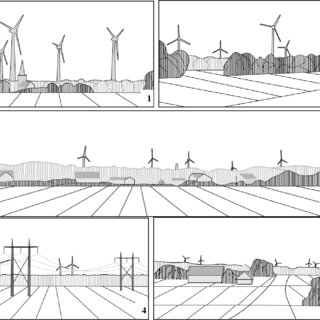
Positive Environmental Impacts
On the positive side, wind energy is generally regarded as environmentally friendly, especially when the environmental effects of emissions from large-scale conventional electrical generation power plants are considered. For example, estimates of the total emissions (sulfur and nitrogen oxides, and carbon dioxide) of coal and gas-fired power plants (German energy mix) as compared to those of wind systems are shown in Table 1. The average wind speed for the wind system was 6.5 m/s. As shown in Table 1, the stack (or direct) emissions of wind systems are generally small (one or two orders of magnitude less than those of conventional power plants). Also, the indirect emissions associated with the actual production of wind turbines and the erection and construction of wind turbine systems and wind farms are small.
| Pollutant | Conventional coal | Gas (CCGT) | Wind |
| Sulfur oxides | 630 - 1370 | 45 - 140 | 2 - 8 |
| Nitrogen oxides | 630 - 1560 | 650 - 810 | 14 - 22 |
| Carbon dioxide | 830 - 920 | 370 - 420 | 10 - 17 |
Table 1
As shown in Table 1, the stack (or direct) emissions of wind systems are generally small (one or two orders of magnitude less than those of conventional power plants). Also, the indirect emissions associated with the actual production of wind turbines and the erection and construction of wind turbine systems and wind farms are small.The determination of the overall cost to society of the various emission pollutants is difficult to measure and open to much debate. One way to calculate the environmental benefits of wind power is to determine the avoided emissions from other sources. These benefits generally come from the displacement of generation (MWh) as opposed to capacity (MW). The displacement of capacity does have its benefits, however, especially if extension of the fuel and water supply infrastructure can be avoided.
As emphasized in a comprehensive report by the Global Wind Energy Council and Greenpeace International, a major driving force behind wind power expansion is the urgent need to combat global climate change. As stated in this reference: ‘This is now accepted to be the greatest environmental threat facing the world. The UN’s Intergovernmental Panel on Climate Change projects that average temperatures will increase by up to 5.8 ℃ over the coming century. This is predicted to result in a wide range of climatic shifts, including melting of the polar ice caps, flooding of low-lying land, storms, droughts and violent changes in weather patterns. Responsibility for climate change lies with the excessive build-up of greenhouse gases in the atmosphere, a trend encouraged by the world’s growing industrialization. Within energy uses, the main culprit is fossil fuels, whose combustion produces carbon dioxide, one of the main greenhouse gases.’
Negative Environmental Impacts
Many publications document the positive environmental aspects of wind power. As more wind turbines and wind farm systems are planned or installed in the world, the importance of their environmental effects has increased. On the other hand, some negative environmental aspects have been shown to be especially important in populated or scenic areas. Here, a number of potential wind energy projects have been delayed or denied permits because of strong opposition based on some anticipated negative environmental effects of these systems.
The potential negative impacts of wind energy can be divided into the following categories:
- Avian/bat interaction with wind turbines;
- Wind turbine noise;
- Visual impact of wind turbines;
- Electromagnetic interference effects of wind turbines;
- Land-use impact of wind power systems.
Visual Impact of Wind Turbines
Aesthetic issues are often a primary reason for concern about wind energy projects. As pointed out by the National Academy of Sciences, however, few regulatory processes adequately address aesthetic issues. One of wind power’s perceived adverse environmental impact factors, and a major concern of the public, is its visibility.
Compared to the other environmental impacts associated with wind power, the visual impact is the least quantifiable.
For example, the public’s perceptions may change with knowledge of the technology, location of wind turbines, and many other factors.

Although the assessment of a landscape is somewhat subjective, professionals working in this area are trained to make judgments on visual impact based on their knowledge of the properties of visual composition and by identifying elements such as visual clarity, harmony, balance, focus, order, and hierarchy.
Wind turbines need to be sited in well-exposed sites in order to be cost effective.
Wind turbines need to be sited in well-exposed sites in order to be cost effective.
It is also important for a wind engineer to realize that the visual appearance of a wind turbine or a wind farm must be considered in the design process at an early stage. For example, the degree of visual impact is influenced by such factors:Wind turbine form;
Electromagnetic interference, EMI, is an electromagnetic disturbance that interrupts, obstructs, or degrades the effective performance of electronics or electrical equipment. Through EMI, wind turbines can have negative impacts on a number of signals important to human activities such as television, radio, microwave/radio fixed links, cellular telephones, and radar.
Wind turbines can present an obstacle for incident electromagnetic waves, which may be reflected, scattered, or diffracted by the wind turbine. As shown schematically in Figure 1, when a wind turbine is placed between a radio, television, radar, or microwave transmitter and receiver, it can sometimes reflect portions of the electromagnetic radiation in such a way that the reflected wave interferes with the original signal arriving at the receiver. This can cause the received signal to be significantly distorted.
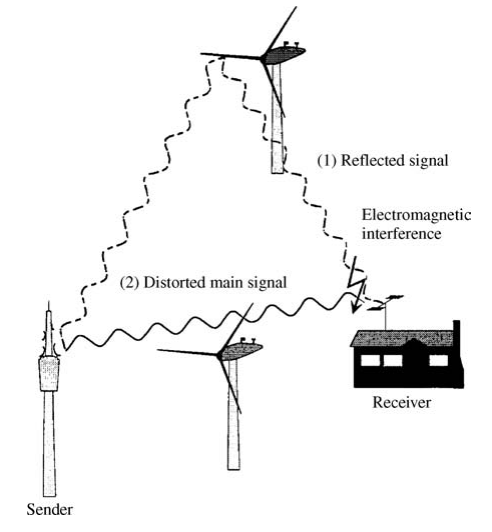
Figure 1
Some key parameters that influence the extent of electromagnetic interference (EMI) caused by wind turbines include:
Land-Use Environmental Impacts
There are a number of land-use issues to be considered when siting wind turbines. Some of them involve government regulations and permitting (such as zoning, building permits, and approval of aviation authorities). Others may not be subject to regulation, but do have an impact on public acceptance. The following are some of the major land-use issues:
Compared to other power plants, wind generation systems are sometimes considered to be land intrusive rather than land intensive. On the extent of land required per unit of power capacity, wind farms require more land than most energy technologies. On the other hand, while wind energy system facilities may extend over a large geographic area, the physical ‘footprint’ of the actual wind turbine and supporting equipment only covers a small portion of the land.
In the United States, for example, wind farm system facilities may occupy only 3–5% of the total acreage, leaving the rest available for other uses. In Europe, it has been found that the percentage of land use by actual facilities is less than the US wind farms in California. For example, UK wind farm developers have found that typically only 1% of the land covered by a wind farm is occupied by the turbines, substations, and access roads. Also, in many European projects, farm land is cultivated up to the base of the tower. When access is needed for heavy equipment, temporary roads are placed over tilled soil. Thus, European wind farms only occupy from 1–3% of the available land.
When one determines the actual amount of land used by wind farm systems, it is also important to note the influence of the wind turbine spacing and placement. Wind farms can occupy from 4 to 32 hectares (10 to 80 acres) per megawatt of installed capacity. The dense arrays of the California wind farms have occupied from about 6 to 7 hectares (15 to 18 acres) per megawatt of installed capacity. Typical European wind farms have the wind turbines spread out more and generally occupy 13 to 20 hectares (30 to 50 acres) per megawatt of installed capacity.
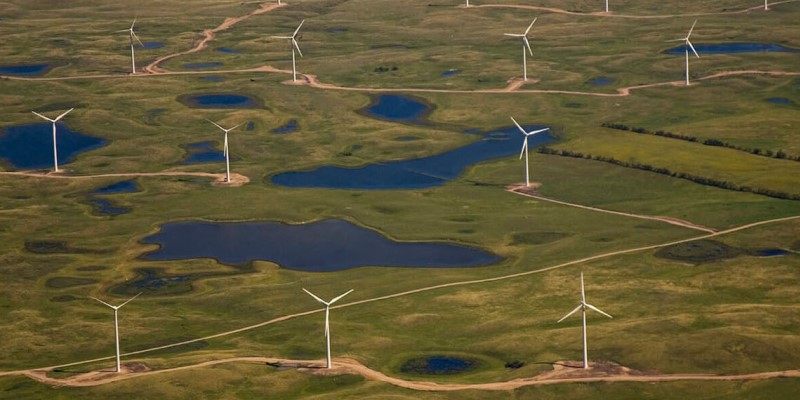
Since wind generation is limited to areas where weather patterns provide consistent wind resources over a long period, the development of wind power in the US has occurred primarily in rural and relatively open areas. These lands are often used for agriculture, grazing, recreation, open space, scenic areas, wildlife habitat, and forest management. Wind development is generally compatible with the agricultural or grazing use of a site. In Europe, due to higher population densities, there are many competing demands for land, and wind farms have tended to be of a smaller total size.
The development of a wind farm may affect other uses on or adjacent to a site. For example, some parks and recreational uses that emphasize wilderness values and reserves dedicated to the protection of wildlife (e.g., birds) may not be compatible with wind farm development. Other uses, such as open space preservation, growth management, or non-wilderness recreational facilities may be compatible depending on set-back requirements, and the nature of on-site development.
- Blade number;
- Turbine nacelle and tower;
- Turbine size;
- Wind farm size;
- Spacing and layout of wind turbines;
- Color.
Electromagnetic interference, EMI, is an electromagnetic disturbance that interrupts, obstructs, or degrades the effective performance of electronics or electrical equipment. Through EMI, wind turbines can have negative impacts on a number of signals important to human activities such as television, radio, microwave/radio fixed links, cellular telephones, and radar.
Wind turbines can present an obstacle for incident electromagnetic waves, which may be reflected, scattered, or diffracted by the wind turbine. As shown schematically in Figure 1, when a wind turbine is placed between a radio, television, radar, or microwave transmitter and receiver, it can sometimes reflect portions of the electromagnetic radiation in such a way that the reflected wave interferes with the original signal arriving at the receiver. This can cause the received signal to be significantly distorted.

Figure 1
- Type of wind turbine (i.e., horizontal axis wind turbine or vertical axis wind turbine);
- Wind turbine dimensions;
- Turbine rotational speed;
- Blade construction material;
- Blade angle and geometry;
- Tower geometry.
Land-Use Environmental Impacts
There are a number of land-use issues to be considered when siting wind turbines. Some of them involve government regulations and permitting (such as zoning, building permits, and approval of aviation authorities). Others may not be subject to regulation, but do have an impact on public acceptance. The following are some of the major land-use issues:
- Actual land required per energy output or capacity per unit of land area;
- Amount of land potentially disturbed by a wind farm;
- Non-exclusive land-use and compatibility;
- Rural preservation;
- Turbine density;
- Access roads and erosion and/or dust emissions.
Compared to other power plants, wind generation systems are sometimes considered to be land intrusive rather than land intensive. On the extent of land required per unit of power capacity, wind farms require more land than most energy technologies. On the other hand, while wind energy system facilities may extend over a large geographic area, the physical ‘footprint’ of the actual wind turbine and supporting equipment only covers a small portion of the land.
In the United States, for example, wind farm system facilities may occupy only 3–5% of the total acreage, leaving the rest available for other uses. In Europe, it has been found that the percentage of land use by actual facilities is less than the US wind farms in California. For example, UK wind farm developers have found that typically only 1% of the land covered by a wind farm is occupied by the turbines, substations, and access roads. Also, in many European projects, farm land is cultivated up to the base of the tower. When access is needed for heavy equipment, temporary roads are placed over tilled soil. Thus, European wind farms only occupy from 1–3% of the available land.
When one determines the actual amount of land used by wind farm systems, it is also important to note the influence of the wind turbine spacing and placement. Wind farms can occupy from 4 to 32 hectares (10 to 80 acres) per megawatt of installed capacity. The dense arrays of the California wind farms have occupied from about 6 to 7 hectares (15 to 18 acres) per megawatt of installed capacity. Typical European wind farms have the wind turbines spread out more and generally occupy 13 to 20 hectares (30 to 50 acres) per megawatt of installed capacity.

Since wind generation is limited to areas where weather patterns provide consistent wind resources over a long period, the development of wind power in the US has occurred primarily in rural and relatively open areas. These lands are often used for agriculture, grazing, recreation, open space, scenic areas, wildlife habitat, and forest management. Wind development is generally compatible with the agricultural or grazing use of a site. In Europe, due to higher population densities, there are many competing demands for land, and wind farms have tended to be of a smaller total size.
The development of a wind farm may affect other uses on or adjacent to a site. For example, some parks and recreational uses that emphasize wilderness values and reserves dedicated to the protection of wildlife (e.g., birds) may not be compatible with wind farm development. Other uses, such as open space preservation, growth management, or non-wilderness recreational facilities may be compatible depending on set-back requirements, and the nature of on-site development.
Post a Comment:
You may also like:

Featured Articles
Economic Impacts of Wind Industry
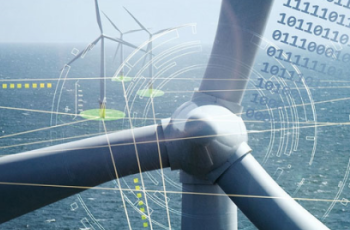 Any business development will have economic impacts on the local and regional economies, and wind energy projects are no ...
Any business development will have economic impacts on the local and regional economies, and wind energy projects are no ...
 Any business development will have economic impacts on the local and regional economies, and wind energy projects are no ...
Any business development will have economic impacts on the local and regional economies, and wind energy projects are no ...Challenges in Wind Industry
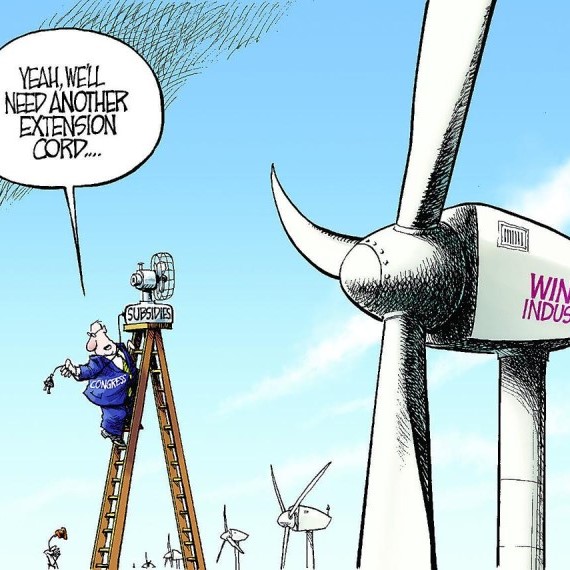 While wind power generation offers numerous benefits and advantages over conventional power generation, there are also some ...
While wind power generation offers numerous benefits and advantages over conventional power generation, there are also some ...
 While wind power generation offers numerous benefits and advantages over conventional power generation, there are also some ...
While wind power generation offers numerous benefits and advantages over conventional power generation, there are also some ...Employment Impacts of Wind Industry
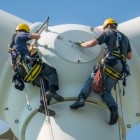 As with most construction and commercial development, wind energy industry create jobs. According to the 2016 Clean Jobs New ...
As with most construction and commercial development, wind energy industry create jobs. According to the 2016 Clean Jobs New ...
 As with most construction and commercial development, wind energy industry create jobs. According to the 2016 Clean Jobs New ...
As with most construction and commercial development, wind energy industry create jobs. According to the 2016 Clean Jobs New ...Wind Energy Cost Trends
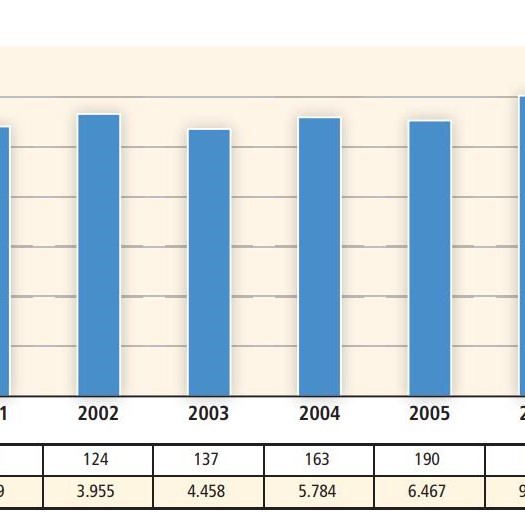 Though the cost of wind energy has declined significantly since the 1980s, policy measures are currently required to ensure ...
Though the cost of wind energy has declined significantly since the 1980s, policy measures are currently required to ensure ...
 Though the cost of wind energy has declined significantly since the 1980s, policy measures are currently required to ensure ...
Though the cost of wind energy has declined significantly since the 1980s, policy measures are currently required to ensure ...Environmental Impacts of Wind Industry
 In recent years, the growth of capacity to generate electricity from wind energy has been extremely rapid, To the ...
In recent years, the growth of capacity to generate electricity from wind energy has been extremely rapid, To the ...
 In recent years, the growth of capacity to generate electricity from wind energy has been extremely rapid, To the ...
In recent years, the growth of capacity to generate electricity from wind energy has been extremely rapid, To the ...